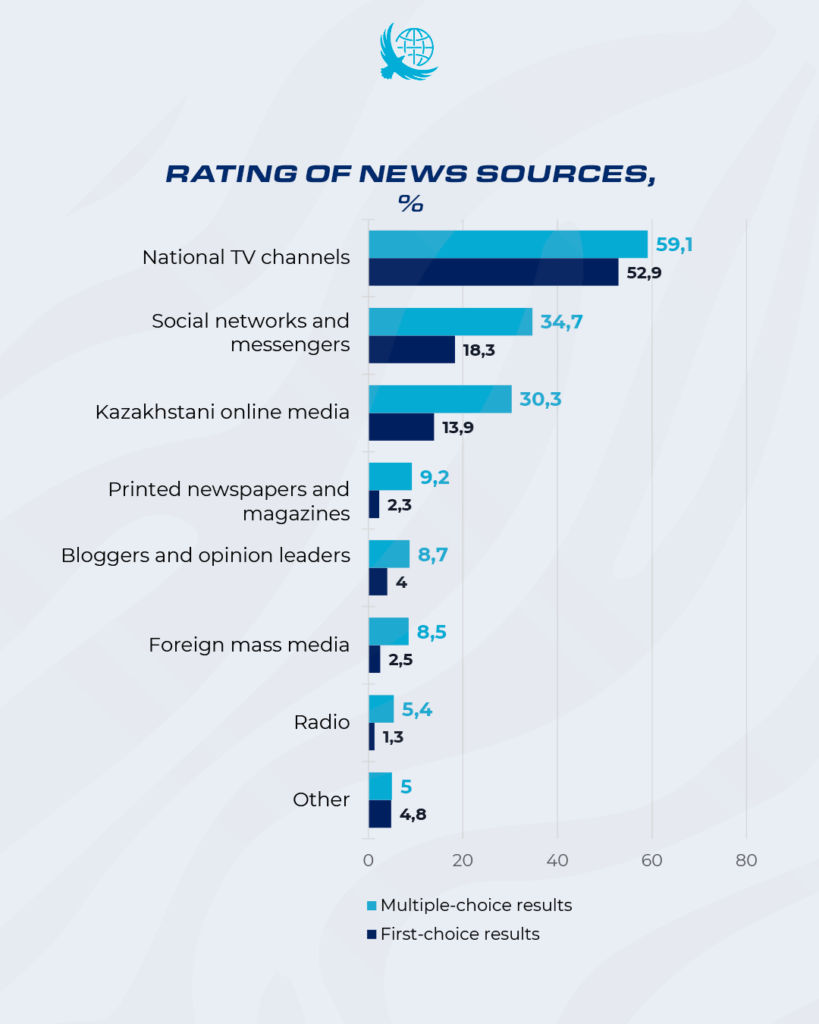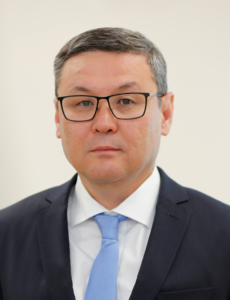
Aigul Zabirova,
Doctor of Sociology, Professor, Chief Research Fellow
at the KazISS under the President of the Republic of Kazakhstan
Nowadays, we increasingly hear that people do not trust any news. But once a truly important topic arises, people still start looking for sources to read, watch, or figure it out. This choice reflects not so much taste, but rather a person’s social identity, generation, and even mood. Today, we will try to understand which news sources are in high demand in Kazakhstan – television, social media, online media, or something else?
In the KazISS[i] spring survey, respondents were asked the question “Which sources of information do you trust most when receiving news about politics, economics, and public life in Kazakhstan?” They were given the following list to select from:
1. National TV channels
2. Kazakhstani online media
3. Social networks and messengers
4. Foreign mass media
5. Printed newspapers and magazines
6. Bloggers and opinion leaders
7. Radio.
The respondents could choose up to three news sources. Overall, we can conduct an analysis based on the first choice, when only the first source is taken into account, and a clear understanding is given of who leads the media space. Multiple-choice analysis could be done as well: a person could choose up to three trusted sources. This approach allows us to estimate the extent and structure of media consumption. Interestingly, our analysis showed that both approaches produced almost identical results which is a rare and significant finding:

Such consistency in estimates indicates a clear hierarchy of trust in news sources in the minds of Kazakhstani people, even if they use several sources at the same time. In other words, respondents are consistent in which media they trust; even when allowed to pick up several sources, they intuitively rank them in almost the same order. All this suggests to the stability of media trust and a fairly well-established information hierarchy in society, especially on issues of politics, economics, and public life. Secondly, despite the continued leadership of the national TV channels, Kazakhstan’s media environment clearly reflects a hybrid model, where alongside the television agenda, social networks, messengers, and digital platforms are playing a greater role. Such composition not only indicates hybridity, but also the nature of the national information landscape, where information navigation with trust is possible. A quality that, admittedly, has become rare in our time.
So, what does the media landscape of the country look like?
1. National TV channels act as the key institutional media hub of the country (59.1%). Indeed, television in Kazakhstan remains the core of official communication. Despite digitalization, TV is still perceived as the main channel of official information by millions of Kazakhstani people, especially on issues of politics, economics, and public life.
2. At the same time, another domain is developing. That is, every third respondent (34.7%) indicates that they trust social networks, which act as alternative, sometimes complementary channels, especially among urban residents and youth. But most likely, these two spheres intersect. So, a person watches the news on TV in the evenings, and reads social networks in the morning.
3. The third place in the trust rating is occupied by Kazakhstani Internet mass media (30.3%), specifically news agencies. This is a significant finding, considering that we are talking about websites which combine traditional journalism with an online format. They work according to journalistic standards, receive government support, and publish high-quality content. Continuing the metaphorical series of the Kazakhstani media archipelago, Internet mass media is defined as the third island of the media field. Notably, this is a fairly diverse category which includes both government-supported resources and independent editorial offices. They deliberately combined publications of different origins and politics into one item to see how much the audience trusts the Internet as such.
4. Printed newspapers and magazines take the fourth place. They are trusted by 9.2% of respondents in Kazakhstan, quite a modest figure, especially compared to television, social and online media. Newspapers and magazines are still read in the regions by the elderly who do not trust the “flashy” headlines of Internet media and prefer a structured, verified presentation. For them, printed publications continue to perceive as a reliable source proven over time, as they contain less emotions and more facts. In other words, the Kazakhstani media environment still retains its multilayered nature, in which the written word has its own audience and its own meaning.
5. Bloggers and opinion leaders were chosen by 8.7% of the respondents. At first glance, that may seem small, but it’s more than just a number. It is not just the fifth place in the trust rating, but a new force that plays by different rules and speaks to the audience in its own, living language. They have no editorial office, budget, or broadcasting license, but they do have the intonation of a “good old friend”, and this is something that traditional media find extremely difficult to reproduce. A blogger is often perceived as the “friend”; there is no distance, they speak a lively manner, and their texts can be replied to in the comments. Bloggers share not only news, but also their lives.
6. 8.5% of the respondents expressed confidence in foreign media. It should be highlighted that, symbolically, the presence of foreign media in the media space signals media pluralism where different views coexist without any dominance. Their low representation, in turn, is an indicator of Kazakhstan‘s media sovereignty.
7. Being chosen by 5.4% of respondents, radio ranks seventh in the architecture of media consumption. It is not that significant, but not negligible either. Like newspapers, radio is part of our media memory, but it works differently. It does not need to be looked at, clicked on, scrolled through, or selected. One can listen to it on the way, in the car, kitchen, or in the background. And that is its strength; it does not impose itself, does not grab attention, but simply accompanies us. Perhaps, that is why it is perceived as a neutral, an “unobtrusive” source, allowing to keep up to date without overloading a person. Most likely, radio stays with those who value not the format itself, but the habit of listening.
Hence, the modern media space of Kazakhstan resembles an archipelago. The map clearly shows islands of different shapes and population densities, with different languages and habits, but united by public attention. National television is located on the largest island, which still retains mass trust. Nearby, there are social networks and messengers, which are mobile, noisy, and, crucially, fast-growing. Internet media (news agencies) looks like an island with a complex coastline; it connects the official and digital worlds, but is not yet able to outrun its neighbours. Further in the archipelago, we see newspapers, radio, bloggers, as well as foreign media. These are already niches, small forms, but their importance is undeniable; some preserve our cultural stability, the second is an individual opinion, and the third gives us a global view of what is happening.
Ultimately, what is important is that the structure of Kazakhstan’s media field is neither a self-elevating pyramid nor a straight line, but a map of islands where each user chooses their own route, occasionally crossing from one shore to another. And the more trust, diversity, and respect for the audience there is in this archipelago, the more stable Kazakhstan’s information ecosystem will be.
[i] The sociological survey was conducted by order of the KazISS in the period from March 20 to April 20, 2025. The sample size is 8,001 respondents. The survey involved respondents over the age of 18 from 17 regions and 3 cities of national significance – Astana, Almaty and Shymkent.


